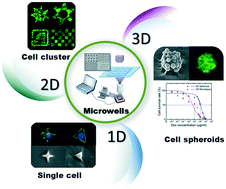Our official English website, www.x-mol.net, welcomes your feedback! (Note: you will need to create a separate account there.)
Mask-free fabrication of a versatile microwell chip for multidimensional cellular analysis and drug screening
Lab on a Chip ( IF 6.1 ) Pub Date : 2017-11-09 00:00:00 , DOI: 10.1039/c7lc01101f Wenguang Yang 1, 2, 3, 4, 5 , Haibo Yu 1, 2, 3, 4, 5 , Gongxin Li 1, 2, 3, 4, 5 , Fanan Wei 5, 6, 7, 8 , Yuechao Wang 1, 2, 3, 4, 5 , Lianqing Liu 1, 2, 3, 4, 5
Lab on a Chip ( IF 6.1 ) Pub Date : 2017-11-09 00:00:00 , DOI: 10.1039/c7lc01101f Wenguang Yang 1, 2, 3, 4, 5 , Haibo Yu 1, 2, 3, 4, 5 , Gongxin Li 1, 2, 3, 4, 5 , Fanan Wei 5, 6, 7, 8 , Yuechao Wang 1, 2, 3, 4, 5 , Lianqing Liu 1, 2, 3, 4, 5
Affiliation

|
Cells are frequently studied because they are basic structural, functional, and biological units of living organisms. Extracting features from cellular behaviors can facilitate decision making in medical diagnoses and represents an important aspect in the development of biomedical engineering. Previous studies have just focused on either the individual cell or cell clusters separately, which leads to a great lack of information. Microwell technologies could address the challenges of in vitro cellular studies, from individual cell studies to 3D functional assays, by providing more information from smaller sample volumes and enabling the incorporation of low-cost high-throughput assays in the drug discovery process. To this end, the present study describes an easy-to-use method for fabricating a versatile microwell chip that utilizes a digital micro-mirror device printing system, and the chip can be employed in multidimensional cellular analysis, ranging from the single cell to the 3D spheroid level. The microwell manufacturing process, using a digital mask in place of a conventional physical mask, is based on shadowed light and is full of flexibility. Three different dimensions (single cell (1D), cell monolayer (2D) and cell spheroid (3D)) of one cell type can be formed using a microwell array and the analyses of biological characteristics are achieved separately. Single cells and cell clusters can be controlled via customized geometries of microfabricated selectively adhesive poly(ethylene glycol) diacrylate (PEGDA) wells. The effects of shape on cellular growth and hybrid tissue layers were investigated by peeling off the microwells. Furthermore, 3D multicellular spheroids were successfully established in a controllable and high-throughput format. Preclinical drug screening was investigated and distinct differences were observed in the tolerance response to drug testing between the 2D and 3D conditions. The study results further demonstrate that the high-density microwell chip is an easy-to-use multidimensional cellular analysis and rapid drug screening technique, and it could be easily adapted for a wide range of biological research applications.
中文翻译:

无掩模制造多功能微孔芯片,用于多维细胞分析和药物筛选
人们经常研究细胞,因为它们是生物的基本结构,功能和生物学单位。从细胞行为中提取特征可以促进医学诊断中的决策,并且代表了生物医学工程学发展中的重要方面。先前的研究仅集中于单个细胞或细胞簇,这导致信息的严重缺乏。微孔技术可以应对体外挑战细胞研究,从单个细胞研究到3D功能测定,都可以从较小的样品量中提供更多信息,并可以将低成本高通量测定纳入药物发现过程。为此,本研究描述了一种易于使用的方法,用于制造利用数字微镜器件打印系统的通用微孔芯片,该芯片可用于多维细胞分析,范围从单细胞到细胞。 3D球体水平。使用数字掩模代替常规物理掩模的微孔制造工艺基于阴影光,并且具有很大的灵活性。三种不同尺寸(单格(1D),可以使用微孔阵列形成一种细胞类型的细胞单层(2D)和细胞球体(3D),并分别进行生物学特性分析。单细胞和细胞簇可以控制通过微细加工的选择性粘合的聚(乙二醇)二丙烯酸酯(PEGDA)孔的定制几何形状。通过剥去微孔来研究形状对细胞生长和杂合组织层的影响。此外,以可控制的高通量格式成功建立了3D多细胞球体。对临床前药物筛选进行了研究,并观察到2D和3D条件对药物测试的耐受性响应存在明显差异。研究结果进一步表明,高密度微孔芯片是一种易于使用的多维细胞分析和快速药物筛选技术,可以轻松地应用于广泛的生物学研究应用。
更新日期:2017-11-20
中文翻译:

无掩模制造多功能微孔芯片,用于多维细胞分析和药物筛选
人们经常研究细胞,因为它们是生物的基本结构,功能和生物学单位。从细胞行为中提取特征可以促进医学诊断中的决策,并且代表了生物医学工程学发展中的重要方面。先前的研究仅集中于单个细胞或细胞簇,这导致信息的严重缺乏。微孔技术可以应对体外挑战细胞研究,从单个细胞研究到3D功能测定,都可以从较小的样品量中提供更多信息,并可以将低成本高通量测定纳入药物发现过程。为此,本研究描述了一种易于使用的方法,用于制造利用数字微镜器件打印系统的通用微孔芯片,该芯片可用于多维细胞分析,范围从单细胞到细胞。 3D球体水平。使用数字掩模代替常规物理掩模的微孔制造工艺基于阴影光,并且具有很大的灵活性。三种不同尺寸(单格(1D),可以使用微孔阵列形成一种细胞类型的细胞单层(2D)和细胞球体(3D),并分别进行生物学特性分析。单细胞和细胞簇可以控制通过微细加工的选择性粘合的聚(乙二醇)二丙烯酸酯(PEGDA)孔的定制几何形状。通过剥去微孔来研究形状对细胞生长和杂合组织层的影响。此外,以可控制的高通量格式成功建立了3D多细胞球体。对临床前药物筛选进行了研究,并观察到2D和3D条件对药物测试的耐受性响应存在明显差异。研究结果进一步表明,高密度微孔芯片是一种易于使用的多维细胞分析和快速药物筛选技术,可以轻松地应用于广泛的生物学研究应用。


























 京公网安备 11010802027423号
京公网安备 11010802027423号